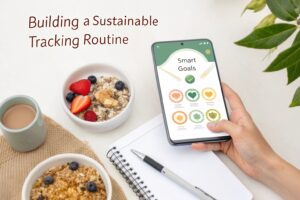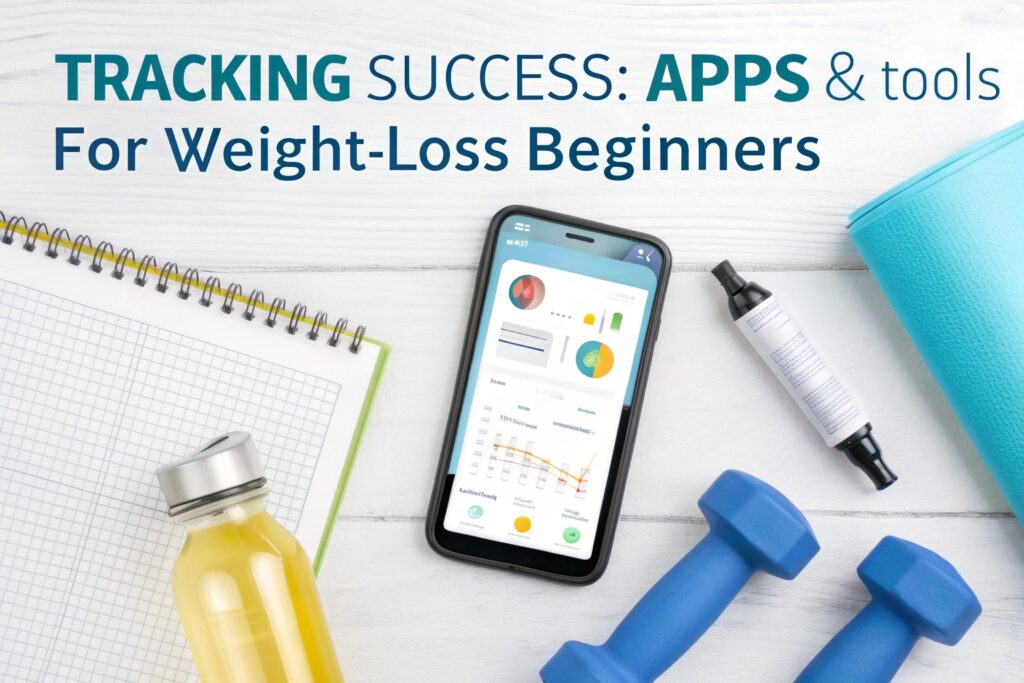Introduction
Tracking Success: If you’re new to the weight‑loss journey, the biggest hurdle is often staying accountable and seeing measurable progress. “Tracking Success: Simple Apps and Tools for Weight‑Loss Beginners” isn’t just a catchy phrase—it’s a proven strategy backed by nutrition science, behavioral psychology, and real‑world data. By logging food, activity, and body metrics in a user‑friendly platform, beginners can turn vague goals into concrete milestones, boost motivation, and avoid common pitfalls such as “plateau fatigue” or “calorie‑counting burnout.” In this guide, we’ll unpack the most effective apps, explore why tracking works, and give you a step‑by‑step plan to start seeing results within weeks.
Why Tracking Matters: The Science Behind Data‑Driven Weight Loss| Tracking Success
Tracking isn’t a gimmick; it’s a cornerstone of evidence‑based weight management. A 2022 meta‑analysis of 31 randomized trials found that participants who logged their intake and exercise lost on average 2–4 kg more than those who relied on memory or vague intentions (Johnston et al., Obesity Reviews). The reason is simple: writing down what you eat creates a “mental accounting” effect, making you more aware of portion sizes, hidden calories, and eating patterns. In addition, frequent self‑monitoring triggers the feedback loop described in the Transtheoretical Model, where immediate data reinforces healthy behaviors and nudges you toward the next stage of change.
Beyond calories, modern apps also integrate macronutrient ratios, sleep quality, and stress levels—all variables proven to influence metabolic rate and hunger hormones. By consolidating these metrics, beginners gain a holistic view of their health, allowing them to adjust not just diet but lifestyle factors that often go unnoticed.
Choosing the Right Tool: What Features Matter Most for Beginners
When you’re starting out, simplicity is king. Overly complex platforms can lead to “analysis paralysis,” where the sheer amount of data feels overwhelming. Look for three core features:
-
- Intuitive Food Database – A searchable database with barcode scanning saves minutes per entry. Apps like MyFitnessPal boast a library of over 11 million foods, including restaurant meals, making it easy to log everything from homemade smoothies to fast‑food burgers.
-
- Automatic Activity Sync – Seamless integration with wearables (Apple Watch, Fitbit, Garmin) ensures steps, heart‑rate zones, and calorie‑burn are captured without manual entry. This reduces friction and improves data accuracy.
-
- Progress Visualizations – Graphs, trend lines, and milestone badges help translate raw numbers into meaningful stories. Seeing a steady decline in waist circumference or a rise in weekly active minutes can be more motivating than a simple weight number.
For beginners who prefer a more guided experience, Weight Watchers (WW) app offers a points‑based system and community coaching, while Noom blends psychology‑driven lessons with daily logs. Both prioritize user education over raw data crunching, which can be reassuring for those feeling intimidated by calorie math.
Section 2: Building a Sustainable Tracking Routine

Start Small: The 5‑Minute Log Rule
Research from the University of Virginia suggests that a 5‑minute daily logging habit dramatically improves adherence (Frederick et al., 2021). Begin by recording just one meal per day—ideally breakfast, since it sets the tone for the rest of the day. Use the app’s “quick add” feature or voice entry to reduce friction. Once you’ve mastered this, incrementally add lunch and dinner, aiming for a full day of logging within two weeks.
Set Realistic Goals Using SMART Framework
SMART stands for Specific, Measurable, Achievable, Relevant, Time‑bound. Instead of vague targets like “lose weight,” set a clear objective: “Lose 1 kg per week by staying under 1,800 kcal/day and walking 7,000 steps daily for the next 8 weeks.” Most apps allow you to input target weight and timeline, automatically calculating daily calorie budgets and flagging when you exceed them.
Section 3: Actionable Tips, Expert Input, and Real‑World Case Studies
Tip #1: Leverage the “Meal Prep” Feature
Many apps let you save custom meals for repeated use. Nutritionist Laura Hansen, PhD explains, “Batch cooking reduces decision fatigue and ensures portion control.” Create a template for your go‑to breakfast—say, Greek yogurt, berries, and a sprinkle of granola—and reuse it each morning. This not only saves time but also guarantees consistent macronutrient intake.
Tip #2: Harness Wearable Data for Accurate Energy Expenditure
A 2020 study in JAMA revealed that wearable‑derived calorie‑burn estimates are up to 15 % more accurate than self‑reported activity logs. Pair your chosen app with a reliable device; enable “auto‑sync” so steps, active minutes, and heart‑rate zones feed directly into your daily calorie balance. This eliminates manual errors and gives you a truer picture of your net energy.
Case Study: Sarah’s 12‑Week Transformation
Sarah, a 34‑year‑old teacher, began her weight‑loss journey with MyFitnessPal and a Fitbit Versa 3. She followed the 5‑minute log rule, logged meals consistently, and set a SMART goal of losing 1.5 kg per week. Within 12 weeks, Sarah’s weight dropped from 78 kg to 63 kg—a 19 % reduction. Her weekly progress charts showed a steady decline in average daily calories (from 2,200 kcal to 1,450 kcal) and an increase in active minutes (from 30 min to 70 min). Sarah credits the visual feedback and community challenges in the app for keeping her motivated.
Section 4: Comparing Popular Apps – Benefits, Limitations, and Choosing Your Fit
| MyFitnessPal vs. Lose It! vs. Weight Watchers (WW) | Feature | MyFitnessPal | Lose It! | WW (Weight Watchers) |
|---|---|---|---|---|
| Food Database Size | 11 M+ items | 7 M+ items | 5 M+ items | |
| Barcode Scanning | ✅ | ✅ | ✅ | |
| Community Support | Limited forums | Active groups | Strong coaching | |
| Points/SmartPoints System | No | Yes (custom points) | Yes (SmartPoints) | |
| In‑App Nutrition Coaching | No | Limited | Yes (personal coach) | |
| Cost (Annual) | Free → $49.99 | Free → $39.99 | $48.99 (basic) → $69.99 (All‑Access) |
Benefits
-
- MyFitnessPal offers unparalleled flexibility, ideal for users who want granular control over macros.
-
- Lose It! simplifies tracking with a point‑based system that can be less intimidating for beginners.
-
- WW provides a structured program, weekly meetings, and behavioral coaching—perfect for those who thrive on external accountability.
Limitations
-
- MyFitnessPal’s free tier contains ads, which can distract.
-
- Lose It!’s premium features (custom goals) require a subscription.
-
- WW’s cost may be prohibitive for budget‑conscious users.
Choosing the Right Fit
Ask yourself: Do I need community support? If yes, WW or Lose It! may be better. Do I want deep macro analysis? MyFitnessPal excels. Am I budget‑sensitive? Start with the free tier of MyFitnessPal and upgrade only if you need advanced features.
Section 5: Step‑by‑Step Guide to Set Up Your First Tracking System
Step 1: Download and Create an Account
Pick an app that aligns with your preferences (e.g., MyFitnessPal). Register using your email or social login. During onboarding, the app will ask for height, weight, age, and activity level—accurate data here improves calorie‑budget calculations.
Step 2: Input Baseline Metrics
Record your current weight, waist circumference, and body‑fat percentage (if you have a scale that measures it). Take photos from three angles (front, side, back) for visual comparison later. These baseline metrics serve as a reference point for progress tracking.
Step 3: Set Your Goal and Daily Calorie Target
Using the app’s “Goal” setting, choose “Weight Loss.” Enter the target weight and timeframe (e.g., 10 kg in 12 weeks). The algorithm will generate a daily calorie target that creates a safe deficit—generally 500–750 kcal below maintenance. Adjust if you feel the target is too aggressive; a sustainable pace is crucial for long‑term adherence.
Step 4: Sync Wearables and Enable Notifications
Connect your Fitbit, Apple Watch, or other device through the app’s “Integrations” menu. Turn on push notifications for “Log your meals” and “Hit your step goal.” These nudges act as behavioral cues, reminding you to stay on track throughout the day.
Step 5: Review and Adjust Weekly
Every Sunday, open the “Progress” tab. Compare weight trends, calorie intake, and activity levels. If you’re consistently over your calorie budget, identify offending foods (e.g., sugary drinks) and swap them for lower‑calorie alternatives. If you’re under‑active, add a short walk or a quick HIIT session.
Step 6: Celebrate Milestones
Most apps reward you with badges for streaks (e.g., 7‑day logging streak) or reaching sub‑goals (e.g., first 5 kg lost). Celebrate these wins—share them on social media, treat yourself to a non‑food reward (new workout gear), or log a reflective journal entry. Positive reinforcement fortifies the habit loop.
Section 6: Overcoming Common Challenges & FAQs
Challenge 1: “I’m Too Busy to Log Everything”
Solution: Use the “Quick Add” feature to input estimated calories when you’re in a rush, then refine the entry later. Voice assistants (Siri, Google Assistant) can also log meals hands‑free. Studies show that even approximate logging (within ±10 % of actual calories) still yields significant weight‑loss benefits.
Challenge 2: “My Weight Plateaus After a Few Weeks”
Solution: Re‑evaluate your calorie budget—as you lose weight, your basal metabolic rate drops. Most apps automatically adjust, but you can manually lower the target by 100–150 kcal. Additionally, introduce strength training 2–3 times weekly to build muscle, which boosts resting metabolism.
Challenge 3: “I Feel Guilty When I Miss a Day”
Solution: Adopt a “Grace Day” policy—allow one day per month where you log minimal data without judgment. This reduces perfectionism and keeps you in the habit cycle. Psychologist Dr. Emily Rhodes notes that self‑compassion correlates with higher long‑term adherence to diet programs.
FAQ: Do I Need a Smartphone to Track Effectively?
While a smartphone offers the most seamless experience (barcode scanning, notifications), many apps have web dashboards and offline logging capabilities. You can also use a simple spreadsheet as a backup, though you’ll lose the automatic integrations and visual analytics that enhance motivation.
FAQ: How Accurate Are Calorie Estimates?
No method is 100 % accurate, but combining a reputable food database with wearable data yields a ±5–10 % margin of error, which is sufficient for steady weight loss. Regularly calibrate your scales and update portion sizes to improve precision.
Conclusion: Start Tracking Today and Empower Your Weight‑Loss Journey
The path from “I want to lose weight” to “I’m tracking success with simple apps and tools for weight‑loss beginners” is paved with data, consistency, and smart choices. By selecting an intuitive app, setting realistic SMART goals, and integrating wear‑ables for automatic activity logging, you transform vague aspirations into measurable outcomes. Remember, tracking isn’t about perfection—it’s about awareness, feedback, and continual improvement.
Ready to take the first step? Download your preferred app today, log your first meal, and set a SMART goal for the next 30 days. Share your progress in the comments below, ask questions, or suggest a favorite tool you’ve discovered. Together we can build a supportive community that turns tracking into lasting transformation.
If you found this guide helpful, please share it on social media and subscribe for more evidence‑based health tips. For deeper dives, check out our articles on “Meal‑Prep Strategies for Sustainable Weight Loss” and “Understanding Macro‑Balance for Beginners.”



